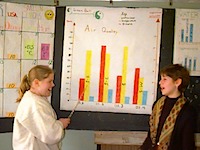
This was a Special Ground-Level Ozone Project modeled after the GTP Projects. Please note the constructivist stages of Invitation, Exploration, Expanation and Taking Action Submitting Data. It is presented here simply to give an idea of the what was the nature of a GTP Web-based project. The project is no longer ongoing.
Procedures for Participation
Welcome |
Stage 1: Invitation |
Stage 2: Exploration |
Materials: You will need the following materials to participate in the project:
- 10 - 14 Ecobadge test strips & color card
- Zikua digital reader---optional (available from Vistanomics, Inc.)
- 1 thermometer
- a wind measuring device (optional)
- a topographic map (so you can determine your latitude and longitude)
- a notebook to record your data
- access to the Web.
Procedure
1. Monitoring: Monitor the ozone for one-week at your location at 2:00 P.M. local time from September 24 - October 12, 2004. To do this place one Ecobadge Test Strip outside at 12:00 local time for ONE HOUR. At the end of the hour collect your Test Strip and record the ozone level by comparing the color of your Test Strip to the Ecobadge Color Card. You might also want to the Zikua, a digital reader. You should also moniter the air temperature, percentage of clouds in the sky, and the wind direction and speed. You might keep a record of your data in your notebook in a table such as the following:
Ozone (ppb) Temperature (C) Wind (speed & direc) Cloud Cover (%) September 24 . . . . September 25 . ; . . September 26 . . . . September 27 . . . . September 28 . . . . September 29 . . . . September 30 . . . . October
- Ozone: report in parts per billion (ppb)
- Temperature: report in degrees celcius
- Wind: report the speed of the wind and direction
- Cloud Cover: report the percentage (%) of clouds in the sky
2. Sharing Your Data: To post your data, go to the International Clean Air Data Form. Here you can share the data by uploading it to a server where you data will be available to other students and schools participating in the project.
3. View Data from Project Participants: You can view the data collected by other students and schools by linking to the Clean Air Data Base. Here you will see everyone's data.
Stage 3: Explanation |
Preparing a Report
Prepare a complete report about what you learned about ground-level ozone in this project. To submit the report, complete the form shown at the "Submit Final Report" button. Part of the report can be a a web page. Your report should include the results of your monitoring, the conclusions you can draw by examining yours and others data, and steps that you think must be taken by your local community to help resolve the problem of ground-level ozone. You might want to look at Marina Goryunova's students web page as an example from a previous project.
To help you with your report and to answer some of questions, you might want to visit one or more of these websites on the content of ozone
- AIRSdata Site---The Air Pollution Monitoring Site.
- Everything you wanted to know about air pollution: An EPA Site.
- Office of Air and Radiation at EPA.
- The Other Ozone---sometimes called the Good Ozone.
Stage 4. Taking Action: Submitting Your Report |

